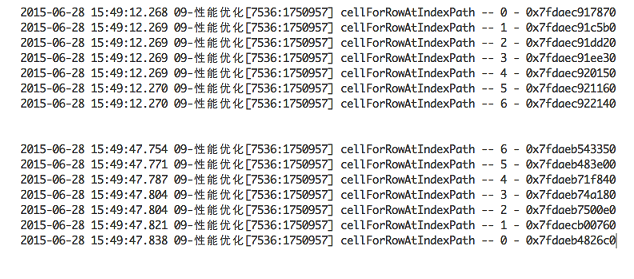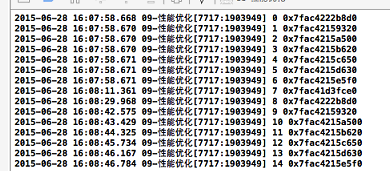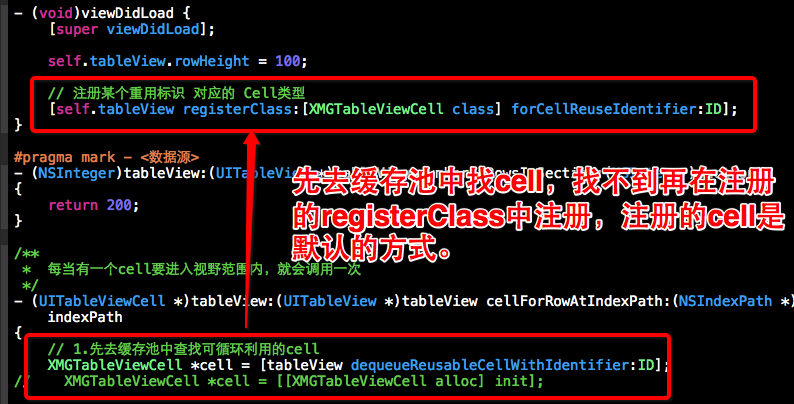iOS-UI控件之UITableView(一)
UITableView
介绍
- UITableView 是用来用列表的形式显示数据的UI控件
- 举例
- QQ好友列表
- 通讯录
- iPhone设置列表
tableView 常见属性
// 设置每一行cell的高度
self.tableView.rowHeight = 100;
// 设置每一组头部的高度
self.tableView.sectionHeaderHeight = 50;
// 设置每一组尾部的高度
// self.tableView.sectionFooterHeight = 50;
// 设置分割线颜色
self.tableView.separatorColor = [UIColor redColor];
// 设置分割线样式
self.tableView.separatorStyle = UITableViewCellSeparatorStyleNone;
// 设置表头控件
self.tableView.tableHeaderView = [[UISwitch alloc] init];
// 设置表尾控件
self.tableView.tableFooterView = [UIButton buttonWithType:UIButtonTypeContactAdd];
UITableView的两种样式只读属性
- 只读属性,在代码中不能修改
UITableViewStylePlain
- 一组显示Section = 1;
UITableViewStyleGrouped
- 分组显示Section >= 1;
展示数据
遵守协议
- UITableViewDataSource
设置数据源
- 连线
- 代码
实现数据源方法
- 先调多少组
//调用数据源的下面方法得知一共有多少组数据
- (NSInteger)numberOfSectionsInTableView:(UITableView *)tableView;
- 多少行
//调用数据源的下面方法得知每一组有多少行数据
- (NSInteger)tableView:(UITableView *)tableView numberOfRowsInSection:(NSInteger)section;
- 每行数据
//调用数据源的下面方法得知每一行显示什么内容
- (UITableViewCell *)tableView:(UITableView *)tableView cellForRowAtIndexPath:(NSIndexPath *)indexPath;
UITableView右边的索引条
- 属性
//设置tableView右边索引文字的颜色
self.tableView.sectionIndexColor = [UIColor redColor];
//设置右边索引文字背景的颜色
self.tableView.sectionIndexBackgroundColor = [UIColor grayColor];
//数据源方法索引信息
- (NSArray *)sectionIndexTitlesForTableView:(UITableView *)tableView
{
//返回的是一个数组,数组中的元素是显示信息,只是提示,结果还是按索引位置分组
return [NSArray arrayWithObjects:@"a",@"b",@"c",@"d", nil];
}
tableView常用方法
//设置分组的头部数据
- (NSString *)tableView:(UITableView *)tableView titleForHeaderInSection:(NSInteger)section
{
return @"头部";
}
//设置分组的尾部数据
- (NSString *)tableView:(UITableView *)tableView titleForFooterInSection:(NSInteger)section
{
return @"头部";
}
**
* 当选中一行的时候调用(点击)
*/
- (void)tableView:(UITableView *)tableView didSelectRowAtIndexPath:(NSIndexPath *)indexPath
{
// XMGWine *wine = self.wineArray[indexPath.row];
// NSLog(@"点击了:%@", wine.name);
NSLog(@"选中了:%zd", indexPath.row);
}
/**
* 当取消选中一行的时候调用
*/
- (void)tableView:(UITableView *)tableView didDeselectRowAtIndexPath:(NSIndexPath *)indexPath
{
NSLog(@"取消选中了:%zd", indexPath.row);
}
/**
* 返回每个cell的高度
*/
- (CGFloat)tableView:(UITableView *)tableView heightForRowAtIndexPath:(NSIndexPath *)indexPath
{
if (indexPath.row % 2 == 0) {
return 50;
} else {
return 100;
}
}
UITableViewCell
- cell 的样式属性
- UITableViewCellStyleDefault
- UITableViewCellStyleValue1
- UITableViewCellStyleValue2
- UITableViewCellStyleSubtitle
-
cell 右边指示样式的属性accessoryView
优先级高于accessoryType
-
cell 右边指示样式的属性 accessoryType
- UITableViewCellAccessoryNone
- UITableViewCellAccessoryDisclosureIndicator
- UITableViewCellAccessoryDetailDisclosureButton
- UITableViewCellAccessoryCheckmark
- UITableViewCellAccessoryDetailButton
-
cell 被点击的颜色变化
iOS 7 之前的- UITableViewCellSelectionStyleNone
- UITableViewCellSelectionStyleBlue
- UITableViewCellSelectionStyleGray
- UITableViewCellSelectionStyleDefault
创建 Cell 的性能分析及优化
cell的重用原理
-
iOS设备的内存有限,如果用UITableView显示成千上万条数据,就需要成千上万个UITableViewCell对象的话,那将会耗尽iOS设备的内存。要解决该问题,需要重用UITableViewCell对象
- 重用原理:当滚动列表时,部分UITableViewCell会移出窗口,UITableView会将窗口外的UITableViewCell放入一个对象池中,等待重用。当UITableView要求dataSource返回UITableViewCell时,dataSource会先查看这个对象池,如果池中有未使用的UITableViewCell,dataSource会用新的数据配置这个UITableViewCell,然后返回给UITableView,重新显示到窗口中,从而避免创建新对象
-
还有一个非常重要的问题:有时候需要自定义UITableViewCell(用一个子类继承UITableViewCell),而且每一行用的不一定是同一种UITableViewCell,所以一个UITableView可能拥有不同类型的UITableViewCell,对象池中也会有很多不同类型的UITableViewCell,那么UITableView在重用UITableViewCell时可能会得到错误类型的UITableViewCell
- 解决方案:UITableViewCell有个NSString *reuseIdentifier属性,可以在初始化UITableViewCell的时候传入一个特定的字符串标识来设置reuseIdentifier(一般用UITableViewCell的类名)。当UITableView要求dataSource返回UITableViewCell时,先通过一个字符串标识到对象池中查找对应类型的UITableViewCell对象,如果有,就重用,如果没有,就传入这个字符串标识来初始化一个UITableViewCell对象
不优化时内存分析
不优化的时候
- 离开可视范围就销毁
- 频繁的开辟内存,销毁内存
- (UITableViewCell *)tableView:(UITableView *)tableView cellForRowAtIndexPath:(NSIndexPath *)indexPath
{
UITableViewCell *cell = [[UITableViewCell alloc] init];
cell.textLabel.text = [NSString stringWithFormat:@"%zd行",indexPath.row];
NSLog(@"cellForRowIndexPath --%zd",indexPath.row);
return cell;
}

优化后内存地址分析

Cell的重用代码
- (UITableViewCell *)tableView:(UITableView *)tableView cellForRowAtIndexPath:(NSIndexPath *)indexPath
{
// 1.定义一个cell的标识
//static 定义变量----只初始换一次
static NSString *ID = @"jrcell";
// 2.从缓存池中取出cell
UITableViewCell *cell = [tableView dequeueReusableCellWithIdentifier:ID];
// 3.如果缓存池中没有cell
if (cell == nil) {
cell = [[UITableViewCell alloc] initWithStyle:UITableViewCellStyleSubtitle reuseIdentifier:ID];
//尽量将cell的初始化设置,放在这个代码块中
//如果这个设置是所有cell都要保持一致的,就可以放在这个代码块中
cell.textLabel.font = [UIFont systemFontOfSize:30];
}
// 4.设置cell的属性...
return cell;
}
cell的重用代码新写法





